The University Church - Sts. Johnsí Church,
Svento Jono baznycia
|
| The University Church was built 1387-1426 and the University added a few years later. The
church tower was erected 1600-1610. The church has burnt several times, and been exposed to war, but has always
been rebuilt. The latest restoration was in the 18:th century. Occupying dictators had it closed and the teachers
deported several times during history, but it has always reopened and continued its duty. For example: during the
Soviet years the church served as science museum. The church has 10 altars, but earlier it had 23! 13 of them were
removed in the beginning of the 19:th century. |
|
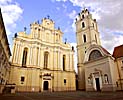
|
The front of the University Church faces the Skargos, Didysis kiemas, the Skargaís Yard or the Great Yard. The
first university rectorís name was Skarga. |
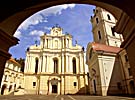
|
Another popular view of the church front, that I am not alone to photograph. It is in all the brochures. |

|
Skargaís Yard photographed from the top of the clock tower. |
|
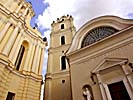
|
The jumble of buildings is apparent in this picture of the church front. To the right is the lecture hall Alma
Mater Vilnensis. |

|
The church tower, Vilniusí highest, 68 meters, photographed from the street, a picture printed in some books about
Vilnius. |
|
|
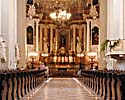
|
The altar looking its best, right before a wedding with lit candles in rows along the aisle and everything covered
in flower petals. |
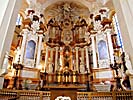
|
Another picture of the altar, with the lights on. Great! Amazing. The church has ten altars in all. |
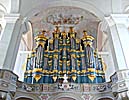
|
The organ is newly renovated, and very well done, too. |
|
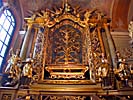
|
St. The chapel of St. Anne with gold, gold and more gold, left and right. |

|
This is a detail of St. Anneís altar with the reliquary. It was hidden for the Russians, but is now displayed
newly polished and splendid. |
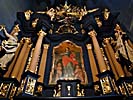
|
Who has seen an all-black altar? It was a first for me. Very difficult
to photograph. |
|

|
St. George and the dragon, a Christian legend that is popular in the Baltics too, stands to the left of the altar.
St. Florian, patron of the firemen... |

|
is to the right of the altar. Note the wooden water. To the right is a collection of all the golden goodies. |
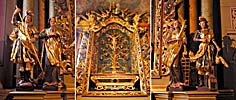
|
Vilniusí Cathedral - Arkikatedra
|
Vilniusí Cathedral the Basilica
is on Cathedral Square. The church was used as an art museum by the Soviets, but was quickly converted to church
again, as Communism disappeared. It is strange to walk around inside this majestic building, and, being aware of
the country's cruel history, to see the guide point to the paintings on the walls, and tell: ďThis is N.N. who
was killed by the KGB, and this is N.N. deported in 1950, and this...Ē
The cathedral has been rebuilt several times since the end of the 14:th century, the last time was in 1783 by Laurynas
Stuoka-Gucevicius, a famous Lithuanian architect. |
|
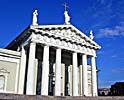
|
The Cathedral front is well known to all who have been to Vilnius. |

|
The bell tower is 52 metres high and free-standing in front of the church. It is the only item still standing of
the medieval castle wall. |
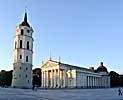
|
The Cathedral is majestic as it rests on the newly renovated Cathedral Square in the evening sun. |
|
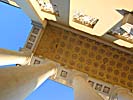
|
Looking up into the ceiling outside the great gate, unveils some beautiful friezes. |

|
Turning down the camera shows the height a little better. |

|
The bell tower in between two pillars. |
|

|
The belfry from the street. Itís the only thing remaining of the old castle wall. |
The three saints on the rooftop have their own story. They stood there before occupation, when the Soviets removed
and crushed them. After Communism an artist made new ones. It took some time, but after seven years they were back
on duty again. Some say they have grown in the meantime. |
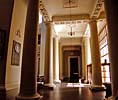
|
The great gate, with a little girl rushing out into the sun. |
| Around all the outer walls are several classicist sculptures of Moses in niches. |

|
|
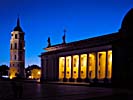
|
Almost night, and the floodlight is beginning to work. |
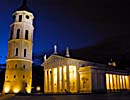
|
The bell tower is also lit up. |
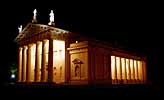
|
Now it's all dark and the light on the three saints on the roof looks good. |
Interior
|
|
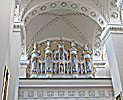
|
The organ is restored and looks great. Note the figurines at the top. |

|
The isle, looking down towards the gate, shot through a hole to the left of the main altar. |
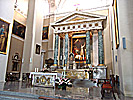
|
The main altar, previously known as the Vytautas altar, because king Vytautas is buried downstairs, along with
other Lithuanian kings. |
|
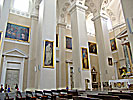
|
During occupation the Cathedral was an art museum. Most of the paintings are gone now. |
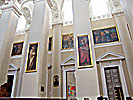
|
Still, there are a lot of paintings. |

|
Left isle, as seen from the altar end. At the far end is the entrance to St. Casimirís Chapel. |
|

|
Virgin Maryís Chapel. |

|
Jonas Basanavicius (1851-1927), was a doctor and freedom fighter, working for Lithuaniaís freedom from tsarist
Russia in 1918. He is more or less a father of the people. He was instrumental in starting the Lithuanian parliament
in 1905 and founded a national democratic party. He also collected stories in the same style as the Brothers Grimm
and greatly affected contemporary literature. As a painter he has depicted old Vilnius in many copperplates. |
St. Casimirís Chapel, Sv. Cazimiero kapella
|
|
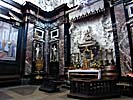
|
St. Casimirís chapel, Lithuaniaís patron saint. He has his own church too. |
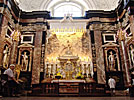
|
Before mass the lights are on and everything looks nicer. |
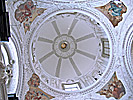
|
The dome is decorated just right. It offers a minute of silent pleasure. |
|

|
A statue of Vladislaus, king of the Polish and the Swedish. Indeed. |
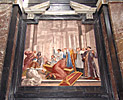
|
As Casimir was a holy man, his relics are able to cure the ill. Here is the scene where a blind man is cured at
St. Casimirís coffin. |
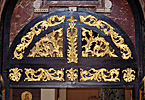
|
The Chapelís gate from the inside. |
|

|
The silvery, upright chest, below the relics chest, hides a painting of Casimir with three arms. |

|
The third arm is impossible to erase, legend has it. Letís zoom a little. |
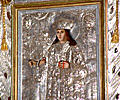
|
And it is true: Casimir has three hands on the painting under the relic chest! |
| So perhaps the legend is true, that tells of the painter first painting the saintís right hand badly and then painted
over it and repainted in another position. To his horror, the next day he saw the original hand appear again! The
legend also says that the badly painted hand canít be painted over, but will always return. I am not prepared to
step up and test this. |
The Gates of Dawn - Ausros
Vartai
|
| The most holy place in Vilnius, and the only piece left of the old northern city wall is
the town gates. During Soviet time there were plans to build a highway, beginning at the Cathedral Square, through
the Old Town (which was to be flattened), knocking down the Gates of Dawn, and onwards to Minsk, in present-day
Byelorussia. Happily, the Soviet Union broke down in time, before these terrible plans were realised. |
|

|
The room where the icon hangs, has high windows facing the street below, and when pope John Paul II visited
Vilnius in September 1993, it was from this room that he greeted the masses. |

|
In 2004 the chapel had been painted blue, although there are no historical proof of it ever having been blue. This
happens to be all the city guidesí favourite spot Most city tours end here at Ausros vartu street with a
visit to the chapel, and then everyone is free to wander around the Old Town. Most of them walk straight into one
of the many cafés. See the buns
department. |
|
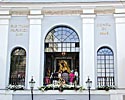
|
If you extend your zoom or get closer to the balcony, you can see the Madonna through the open windows. |
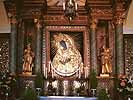
|
An early wide-angle trial done on silver film, with high contrast. |

|
This Madonna close-up is a little faked. I have enhanced the contrasts of the face and hands for better viewing. |
| The sanctuary is one small room only, with one large painted icon, clad in gold plates. The room is considered
the most holy place in Vilnius. The painting behind the gold plates is a Western renaissance masterpiece by an
unknown artist, painted on wood boards. The gold was added later. The room is never empty. There are always worshippers
kneeling, although outside this image. The walls of the room are clad in silver plates, with tens of thousands
of hammered-out, cut-off arms, legs and hearts, symbolic offerings to Virgin Mary in thanks for faith-healing.
It does look mighty strange. Rumour has it that there is a secret chamber behind the icon, housing all the jewels
and other goods that was sacrificed through the centuries. The Soviets didn't find it. |
|

|
Another close-up of the Madonna. There is a large
version too. Yum! |

|
An upright panorama of the altar from the far end of the room. |
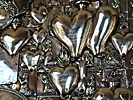
|
Here are the strange, hammered-out silver plates close-up. |
|
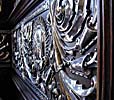
|
Thereís lots of silver, in fantastic formations. But itís slightly faked. The brass shines through where the silver
is worn. Perhaps the silversmith got his part, too? |

|
ďMater MisercordiæĒ the painful motherly love, it says on the frieze blew the clock, that would in fact need
some restoration. |

|
View down the Ausros Vartu from the balcony, the view that the Pope saw when he was there in 1993. |
|

|
But mainly, the Ausros vartai is a gate through the city wall. This is what it looks like from the outside. |

|
Well, it isnít painted blue on this side, at least. You see the opening where the iron gate would fall down. |
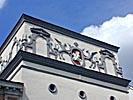
|
At the top is the Lithuanian coat of arms since 1366, the Vytis, a white knight. |
|
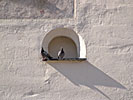
|
The doves like it in the sun in a niche outside the Ausros Vartai. |
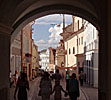
|
Ausros Vartu Street pictured from inside the gate. |
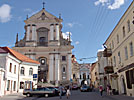
|
And if you go further down the street, past St. Thereseís and look back you canít see Ausros Vartai for all the
tourists. |
St. Church of St. Therese - Sventos
Tereses baznycia
|
| Sharing a wall with the Ausros Vartai is the Church of St. Therese During the Soviet years,
when the Cathedral was used as art museum, St. Therese was used as cathedral. |
|

|
St. Thereseís Church from Ausros Vartu street. Note the Ausros Vartai in the background. |
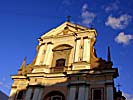
|
St. Thereseís Church at sunset. |

|
The sun shone through the stained glass windows and made nice coloured patterns on the floor, but I had to let
them go, in favour of the church's other splendours. |
|
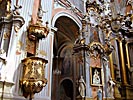
|
It is decorated in rose and gold and looks magnificent, although it is slightly dark. |
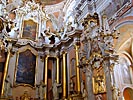
|
The main altar and up along the walls. The golden figures whizz around, heaven opens, the sun shines... |
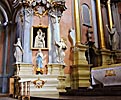
|
yes, all the goodies at the same time. Here is a side altar with a magnificent, gilded painting of Mary and the
child. |
|
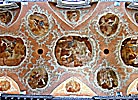
|
This ceiling is simply too much. |
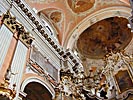
|
The ceiling as it changes into richly decorated walls. |
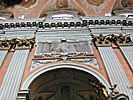
|
Hereís just one of the extremely well preserved portals. |
|
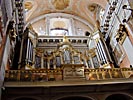
|
I have never heard the organ, but it looks like itís capable of some fine bass notes. |
Not far from St. Therese is a great
café, where you can go after your eyes have had theirs, to let the stomach have its fill.
|
The Church of St. Anne - Sventos
Onos baznycia
|
| No doubt the best-looking church facade in Vilnius.. The St. Anne's is said to be the most
beautiful church in the whole of Lithuania, and I cannot but agree. It is also said that Napoleon wanted to bring
it home ďin the palm of his hand,Ē but that story seems to be told of all churches where Napoleon once set foot.
Well, he didnít take St. Anneís with him, but took some other stuff from Vilnius. |
|
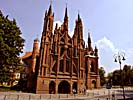
|
St. Anneís Church from Maironio Street. |
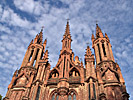
|
The church front must be the most complex and beautiful brick construction conceivable, with thin arcs and projections. |
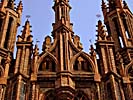
|
Notice the horizontal, spiralling beams. |
|
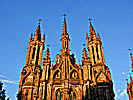
|
The red bricks look much redder in dramatic evening sunshine. |

|
You zoom like crazy to get all the wonderful details. |

|
Small bars, metallic flags, spiral pillars, profiled bricks. |
|

|
Perfect symmetry, 45-degree angles and everything crowned by a typically Lithuanian cross. |

|
The church, belfry and Bernadine Church behind. |

|
A little sideways, with my back to the bell tower. |
|
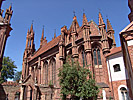
|
Here, weíre standing at the gate of the Bernadine Church, seeing the back end of the St. Anneís. |
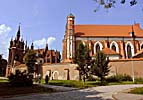
|
The Bernadine Church is right behind the St.
Anneís. It is presently undergoing restoration. |
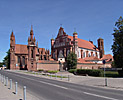
|
As you go farther away on Marionis Street, it is obvious that the St. Anneís can easily fit within the Bernadine
Church. |
|
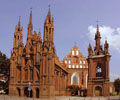
|
St. Anneís Church ha a free-standing belfry looking slightly silly in comparison. |

|
The bell tower is kind of heavier. Itís built by another master, and he just simply wasnít as good. |

|
You can find an infinite amount of fantastic angles. You can also see how thin and fragile the brickwork is. |
|

|
33 different types of brick were used. |

|
A picture of Christ above a little niche in the wall, where someone has put flowers. There are details everywhere. |

|
The Bernadine Church behind St. Anneís in a fantasy-provoking under-up-shot. |
|
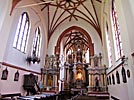
|
The interior is very round-ish and looks quite ďheavyĒ. |
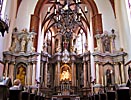
|
The side altars are just too big. They look very massive. Note the blue spots if light. |
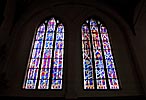
|
The stained glass is mostly blue, throwing wonderful blue spots of light everywhere. |
|
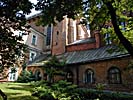
|
The vicarage, the office or whatever, in a garden to the left of the main building. |
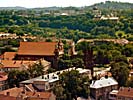
|
From some distance, shot from the top of Gediminasí Tower, the church looks like this. The St. Anneís in the middle
of the picture can be hard to discern for a non-St. Anne-ologist. The Bernadine Church is to the left and the angular
building to the right is what is left of the Bernadine abbey. |
|

|
Adomas Mickevius (Mits...), a Lithuanian poet who has written beautifully about Vilnius in Polish... |

|
...so much that the Polish started to view Vilnius a Polish city. Here he is, dreaming, to the right of the abbey.
But all he did was adjusting to his customersí demands. Polish was the language of choice then. |
St. Church of St. Nicholas - Svento Mikalojaus baznycia
|
| St. Nicholasí church at Mikolajus gatve
is Vilniusí oldest. It is mentioned already in 1387 but was probably built a few years earlier. It seems to have
stood up against time quite well. It remains unchanged in Gothic style, from the time when Lithuania was christened. |
|
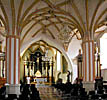
|
It is obvious that St. Nicholasí is very old. It is dark and the ceiling is low. |
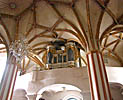
|
The sunís rays, the spidery sticks painted in the ceiling, give a feeling of ďWow, something is coming out of the
brickĒ. |
The walls are almost featureless and the organ loft is all white. There have been lots of paintings
here.
|
|

|
Left side altar. There were paintings on these walls before. |
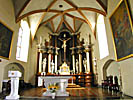
|
The altar is quite modest. And all black, which is unusual. And hard to photograph. Thereís another hard-to-shoot
altar here. |

|
Right side-altar. Look at the angelsí golden wings. |
|

|
An ancient wall leaning in all directions surrounds the church. |

|
The church is consecrated to Vytautas the Great. Heís staring at us from the wall. It was he who christened Lithuania. |

|
This church is really old. It is obvious because the wall is curved outwards from age. |
The Church of the Holy Spirit - Sventos Dvasios baznycia
|
The building begun in 1501, but is has burnt several times since. The latest renovation,
in late Baroque and rococo happened 1752-1760. The Baroque organ was added in 1777 built by the master Casperini
Gottlieb. Napoleon pinched parts of the interior in 1812 as he was running from the Russian army, but it was returned
in 1815. The church was open during the Soviet years, but the nearby monastery was closed. It is now the main church
for the Polish in Vilnius.
The church has 3-4 floor beneath the ground, used as shelters during wars and epidemics. During the e.g. 1930ís
a whole storey full of desiccated corpses was found. A bit further down the Dominikonu
gatve is the Church of the Holy Cross. |
|
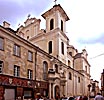
|
The church is built into the building along the Dominikonu gatve. In the front is a Christian bookshop. |

|
During mass the light is different. |
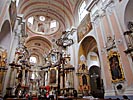
|
The church has 16 altars. Where have they put them? As you get inside, you just stand there with your mouth open. |
|
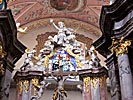
|
The Lord sits on an arch in the air over the main altar. |

|
First you think that the ceiling is all in rose... |

|
but then you se that itís rose and sunny yellow. The dome is 49 metres high. Look at all the detail! |
|
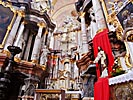
|
The main altar, well you can hardly see it. Itís almost too good. |
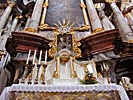
|
Left side altar. With its front clad in silver and gold plates. |
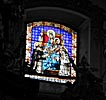
|
The holy family painted on glass. |
|

|
Let us get closer to the right side altar... |
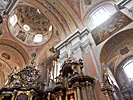
|
We raise our eyes and lenses towards the ceiling... |
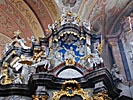
|
and check out the exquisitely detailed sky with angels and everything at the top. |
|

|
Left rear altar, a bit dark and secluded. |

|
The right rear altar is also badly lit. |

|
In the middle of the church is an altar with a constantly lit picture of Christ. ďJezu, ufam tobieĒ means ďJesus,
we trust youĒ. ďJezu, ufam tobieď means ďJesus, we trust in youď. |
St. Constantin and St. Michaelís Church
(The Romanoff Church) - Romanoff cerkve
|
| On Basanavicius Street, a bit away from the city centre, youíll find the Russian Orthodox
church built to commemorate the 300:th anniversary of the reign of the Russian Romanoff tsar dynasty. The citizens
of Vilnius informally calls it The Romanoff Cerkov.
The church was built between 1911-1913 and the tsar could enjoy it in the then free Lithuania until the family
was brutally murdered by a Bolshevik death squadron one day in July 1918. Cerkov is the Russian word for church,
but the Lithuanians take great care to differentiate between cerkve (Russian Orthodox church) and baznycia (Catholic church). |
|

|
Isnít it yummy? Doesnít it look like some pastry with green mint topping? |

|
Newly renovated on the outside, it shines in white and green. All the scrolls make you think of something Arabic. |
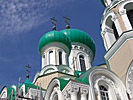
|
It is good enough to eat. Just give me a big enough spoon. |
|
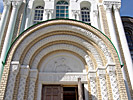
|
ďGod bless and save mankindĒ the old Cyrillic writing above the door says, more or less. |
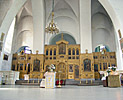
|
Inside its sparsely decorated, not at all like the rich sobors that are probably getting money from Moscow to... |
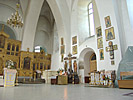
|
show an attractive facade, such as the sobor in Palanga.
Perhaps the Romanoffís arenít all that popular in the Kremlin? |
St. Church of St. Casimir - Svento
Kazimiero baznycia
|
St. Casimir is the patron saint of Lithuania. He was a kings son, a Christian person who
died very young (about 25 years). His remains are revered as miraculous and many claim to have been healed by him.
Well anyway, the Jesuits started building the church in 1604, using builders from Vilnius. The church has burned
many times and was latest rebuilt 1749-1755. It was changed into a Russian-Orthodox church in 1864, and the crown
was removed in favour of a bulbous dome. An iconostase was put in front of the altar, etc. In 1925 it was back
to Catholicism again, and in 1842 the crown was back.
During the Soviet days the church was used as a Museum of Atheism. You don't say? Today it is the patron of youth.
The classicist building to the right in the first picture was once the City Hall. |
|
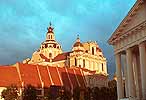
|
During an evening walk the sun illuminated St. Casimirís Church, a baroque masterpiece from the 17:th century.
The picture kind of threw itself at me, ordering to be photographed. |

|
Note the fancy crown on top of the tower. One must admit Vilnius has style, compared to concrete-Stockholm. |

|
The church has no ordinary bells. Instead it has a wind-driven carillon, like wind chimes. |
|

|
If you stand in the doorway and canít get in, as when I took this picture, it looks like this. |

|
The next year the church was open and all the splendour was there, for my shutter to snap at. |

|
ďMajesticĒ is a grave understatement when it comes to this main altar. |
|
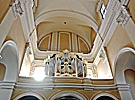
|
The organ: small, compact. Everything is creamy white. |
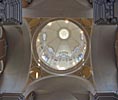
|
Have a look at the dome. Itís cream colour, too, probably because the paintings were destroyed. |
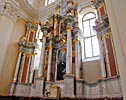
|
The side altar is just as majestic as the main altar. You hardly know which one to choose. |
All Saintís Church - Visu
Sventuju baznycia
|
| ĒAll Saintís ChurchĒ literally means a church for all conceivable saints, all at once. Hence
the enormous amount of side altars. A real Christian pantheon. |
|
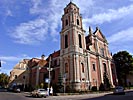
|
Where the Visu sventuju gatve, (All Saintís Street) crosses the Rudininku gatve is the All Saintís
Church, just recently restored and opened (2004). The rose facade is decorated with spirals à la Princess
Leiaís hairstyle. |
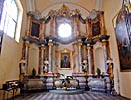
|
To the right of the main altar youíll find a side chapel. |
|

|
Left front side altar, consecrated to St. A. |
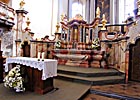
|
The main altar is really inflated baroque style, almost like an enormous old-style bathtub. |
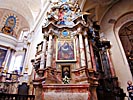
|
Right front side altar, consecrated to St. E. |
|

|
Left side altar #1, consecrated to St. A. |
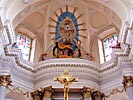
|
In the ceiling above the altar Trinity is peeping down from a blue sky with sunbeams and fat angels around. |

|
Right side altar #1, consecrated to St. F. |
|

|
Left side altar #2, consecrated to St. B. |
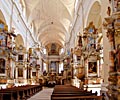
|
And this is the whole shmere, 11 altars in all. |

|
Right side altar #2, consecrated to St. G. |
|

|
Left side altar #3, consecrated to St. C. |

|
Even though the ceiling is not painted, it is über-powering. |

|
Right side altar #3, consecrated to St. H. |
|

|
Left side altar #4, consecrated to St. D. |
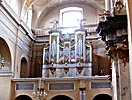
|
The organ, with angelís trumpets and all. |
Oops, I mustía missed an altar there...
|
Any suggestions for the saints involved? |
The Church of the Holy Cross - Sventu kryziaus baznycia
|
| The Church of the Holy Cross on Dominikonu gatve
was opened in 2004, unbearably modern inside. Terrible! I can but regret the massive damage
that must have been behind the complete modernisation. Right next to it is the Church of the Holy Spirit . |
 |
This church is just a part of the wall of a larger building right by the University. |
 |
Inside the walls are completely devoid of medieval illustrations. Everything is flattened. The altarpiece is psycho-modernistic,
empty, the guess-it-yourself model. |
 |
I found only this one painting of the Madonna, but it was nauseatingly modern. Why? |
|
